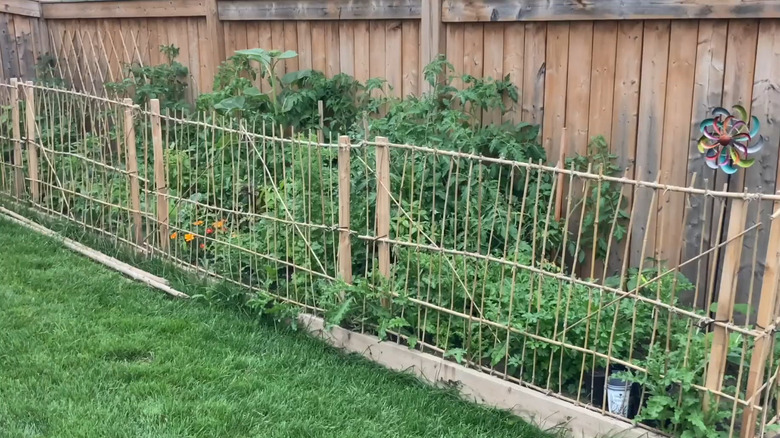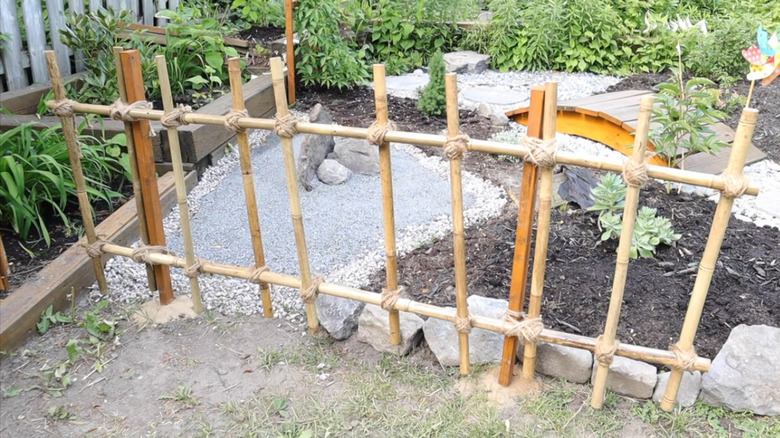Keep Pets And Pests Out Of Your Garden With A DIY Bamboo Fence
We may receive a commission on purchases made from links.
Keeping pets out of your garden is not only important for aesthetic reasons, but also for safety. Indeed, there are many popular flowers you need to keep pets away from, like chrysanthemums and eucalyptus, as these species can be toxic to them. Building a simple DIY fence is a fast and affordable way to ensure that your four-legged BFF stays safe while your beautiful landscaping (or vegetable patch) keeps thriving. What's more, even if you don't have your own pet, a garden fence is a great way to keep neighborhood dogs from damaging your precious lawn. Plus, it can also help banish garden pests, like raccoons, rabbits, and deer.
You can, of course, buy readymade fencing, but DIYing your own can save you some cash and offer a fun weekend project. Bamboo is a great material to work with, as it's sustainable, lightweight, and very pretty. It's also durable and can be used to keep animals out of your garden while adding a beautiful designer touch. While 8 feet of bamboo fencing can cost well over $120, you can achieve the same effect for a lot less with a few simple supplies, namely jute string and bamboo stakes. You can purchase the latter in packs on Amazon where 50 2-foot stakes cost under $26.
How to DIY a pretty bamboo fence for your garden
Determine the length and height of the fence you need. When considering how tall to build, think about what you're trying to keep out of your garden. While 2 feet in height will keep rabbits out, you'll need to go at least 3 feet high for cats and dogs and over 8 feet for deer. Choose stakes that best fit your requirements, or size up and use a hand saw to cut them as needed. Next, place two stakes down on a flat surface horizontally to create the upper and lower "rails" of your fence. Attach vertical stakes to these using jute string, making sure they're close enough so as not to allow animals to squeeze through.
YouTuber @lauracoteDIY suggests using a sturdy Japanese square lashing knot to tie your pieces together. While this may take a bit of time to master, it will ensure your bamboo is held together tightly and won't be easily knocked apart by any curious creatures. Once you're done with the knots, thread an extra horizontal stake across the middle (going over and under the vertical stakes) for added sturdiness.
Finally, insert hardwood stakes (The Home Depot sells a 6-pack for under $10) into the soil and attach your bamboo panels using more jute string. If you're placing your bamboo fence in an area you'll need regular access to (to weed, for example), leave the end of one panel unattached and latch it onto your hardwood stake using a gear tie — this will allow you to easily swing it open.
Another DIY bamboo fence idea
If the fancy knotwork suggested by @lauracoteDIY seems too intimidating, or you simply want to save some time, YouTuber @Sasa Time has an alternate method to DIY a bamboo fence, using nylon cable ties instead. Once you've decided on your fence size, lay down two horizontal stakes on a flat surface to form a frame, as above, but this time, use a drill and nylon ties to attach vertical stakes to them. Drill two holes in the bamboo pieces that will be attached vertically, one at the top and one at the bottom, but keep in mind that bamboo can be prone to splintering. To avoid this, apply minimal pressure and drill as slowly as possible. Once that's done, thread your nylon ties through the holes, then wrap the ties around the horizontal stakes and pull them fast, so they hold the bamboo in place tightly. You can then use some jute cord to add a decorative element on top of the ties and hide them from view. To install your creation, drive hardwood stakes into the ground and attach your DIY bamboo fence to them using additional jute string.
And remember: Once fenced in, you can make your garden even more unattractive to critters and pests with some DIY deterrents. This can be as simple as mulching your plants with coffee grounds or spritzing them with an anti-lawn-pest cayenne pepper solution made with 10 ounces of water and one teaspoon of cayenne pepper.


